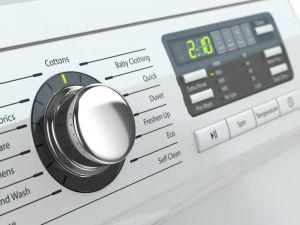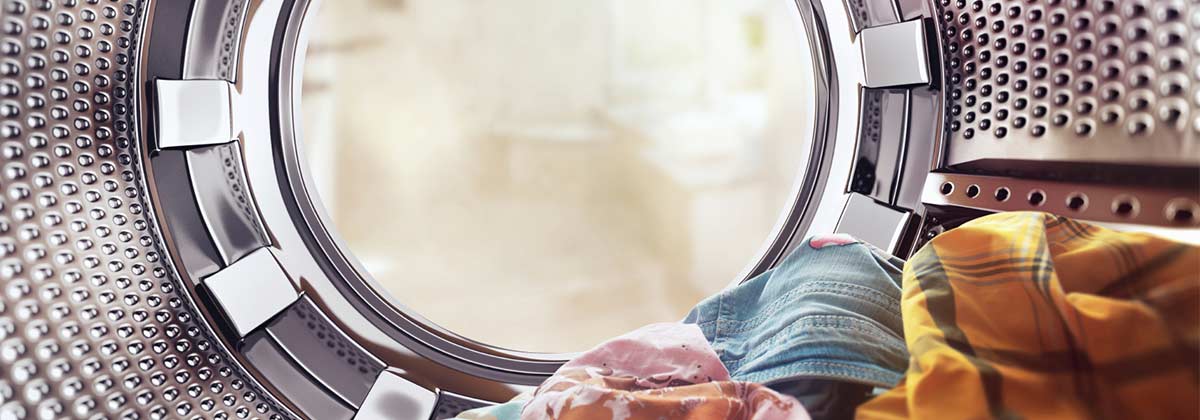Whether you’re a first-time buyer or a seasoned white goods owner, buying a new clothes dryer can be a daunting experience. New features and technology can make the process confusing, and if your household has expanded since the last time you bought a dryer, you might not be too sure about what capacity is suitable for you and your family. On top of that, clothes dryers are one of the most energy-hungry appliances you’ll ever own, so energy efficiency needs to be top of mind.
While some of the important aspects of appliance buying are purely personal and subjective, we can certainly try to give you a hand with the more factual parts of shopping for white goods. So, this is our buying guide for clothes dryers, complete with all the knowledge we can offer to help you make the best choice possible.
What size clothes dryer do I need?
If you’re wondering what size clothes dryer you need, here are the things to take into consideration. Dryer capacity is measured by the weight of dry clothing (not wet clothing) that can fit in the drum. However, if you’ve never gone to the lengths of figuring out how much your laundry actually weighs, the numbers will be fairly meaningless to you. The fact is that you simply need a dryer that can handle your laundry.
So, here’s what you do:
- Grab a scale (borrow one from a friend if you don’t have one)
- Weigh your laundry basket without anything in it. Record the weight
- Fill your basket with a week’s worth of laundry. Weigh it and record the number
- Subtract the empty basket weight from the total and you’ll know how much your weekly laundry weighs
Now you’ve done that, here is a guide to clothes dryer sizes and weights. Keep in mind that buying a dryer with a capacity slightly greater than what you probably need isn’t a bad idea because you never know when you’ll need to wash a huge load of linen or towels, and you’re better off with too much than you are with not enough. Matching your clothes dryer size to that of your washing machine will cater to both.
| Dryer capacity | Suitable for |
|---|---|
| 6.5kg or smaller | 1-2 people |
| 7-8.5kg | 3-4 people |
| 9kg or greater | 4+ people |
Clothes dryer size
Before you go and buy anything, make sure to measure the space you’ve got in mind for the new dryer to occupy. Don’t put yourself through the heartbreak of buying what you think is the perfect dryer, only to bring it home and discover it doesn’t fit. It is also a good idea to measure the appliance you’re looking at, even if the dimensions are specified on the tag or the website, just in case of any errors.
Also keep in mind that, from a safety perspective, it’s a good idea to leave a decent amount of space between your dryer and the wall, or other appliances.
Different types of clothes dryers
Believe it or, while all dryers more or less look the same, they’re far from uniform in terms of how they work. There are a few different types of clothes dryers, with some being more efficient than others. Here’s a breakdown of the main types of clothes dryers that you’ll run into.
Vented dryers: The most basic, stock-standard model of clothes dryer, vented dryers heat up air and then pass it into the drum holding the clothes. Once the hot air has become too moist to dry any further, it’s vented out of the drum and replaced with new, dry air. These are generally the cheapest clothes dryers you can buy, but lower energy efficiency makes them more expensive in the long term.
Condenser dryers: Similar to a vented dryer, but far more energy efficient, condenser clothes dryers take moisture-laden air and, as the name suggests, condense it into water, which is then either stored in a water tank or drained away. They don’t require any ducts or vents for hot air which makes them easy to install, but they will increase the moisture level in your laundry room. They’re more energy efficient than their vented counterparts but they’re also more expensive upfront.
Heat pump dryers: Generally, the most energy-efficient kind of dryer that you can buy, heat pump dryers use a heat pump to heat air, but then after the air has become damp it’s cooled to extract the water and reheated for use again. It’s a locked cycle, making them both efficient and convenient, and unlike other types of clothes dryers, a heat pump dryer won’t create heat or moisture in your laundry room. According to The Good Guys, a heat pump dryer uses less than half the energy per load of a condenser or vented dryer.
Gas-powered dryers: These are similar to standard vented dryers, but use a gas burner instead of electricity to create heat. Gas-powered dryers are generally more energy efficient than vented models, but will cost more to buy upfront.
Washer/dryer combos: Sacrificing overall energy efficiency for the convenience of having your washing machine and dryer in one appliance, washer/dryer combos are an appealing option for those in small homes or apartments. However, the two-in-one nature of these models renders them a jack of all trades and a master of none. Not only are they generally slower than using two separate machines, but you also can’t multitask, meaning that you can’t put another load of washing on while the previous one dries, making laundry day significantly less efficient. These units also usually have higher repair costs and aren’t really that much cheaper than just forking out for the separate machines. That’s why despite some brands’ best efforts, washer/dryer combos just have not been that popular.

Clothes dryer features
While you’ll always be able to pick up a cheap bare-bones dryer that lets you simply press start, you might want to take a look at the features offered on some of the better-kitted models. Some of them are pretty handy and may even save you some time and money.
Moisture sensor: Dryers equipped with this feature will be able to sense when your clothes are dry, and then cut the cycle short accordingly. This can obviously save you quite a bit in terms of energy expenditure – up to 15%! While models with this feature might also come with a higher price tag, consider the potential savings you’ll make on future energy bills.
Variety of programs: It’s a basic rule of thumb that the more expensive your dryer, the more programs it’ll come with. Quick cycles and dedicated programs for light and heavy garments are some of the more basic programs you’ll find on dryers, there are many more to be found on higher-end models. While these may sound like additional extras that you probably don’t need, consider the fact that they’re there for efficiency purposes. If you have an item of clothing that’s just a little damp, running it a on quick cycle rather than a full one will save you energy, and subsequently, save you money.
Delayed start: This is another function that may initially seem pointless, but for those looking to save energy this feature could be just the ticket. Depending on your provider, electricity can cost varying amounts at different points in the day due to tariffs and ‘off-peak’ times. Setting your dryer to run during off-peak times of day could save you some serious dollars on your energy bills for exactly zero additional effort on your part.
Steam drying: A slightly more recent innovation in the field of clothes dryers, steam drying offers a number of advantages over regular hot-air drying. Among other things, it can sterilise your clothes, make them significantly easier to iron and kill off any nasty smells that may linger in your clothes. This is definitely worth the investment if you can afford it. An alternative would be a garment steamer, which gets rid of wrinkles and disinfects your clothes, with prices starting from as little as $20.
Stackable dryers: If you are short on space in the laundry but still looking to add a dryer to the collection, consider a stackable one. This saves space as you can put it right on top of a front-loading washing machine, freeing up floor space for other things. Something to keep in mind however is that some manufacturers only offer dryers that can be stacked on top of washing machines of the same brand.
Child lock controls: If you’ve got little ones who like to press buttons and explore, it’s important to consider a unit with adequate safety features like child locks. This typically requires a certain button combination to be pressed before the dryer can open or start, meaning that your children won’t be able to accidentally start the cycle. Households with children are advised to avoid machines with an auto-start feature due to the possibility of a small child climbing in and shutting the door behind them.
Dampener system: If the dryer is going to be near living areas or bedrooms, a dampener system may be beneficial. This reduces the operating noise of the dryer to make the whole experience nicer for everyone, especially if you live in a smaller space such as an apartment.
Energy efficiency and cost
With rising living costs showing no signs of slowing down, Australian householders are overwhelmingly concerned that they won’t be able to afford energy within three years, a national survey revealed. Because of this, energy efficiency is front of mind for many households, especially before clothes dryers are notoriously inefficient. The initial outlay of a clothes dryer can be significant, but it’s the running costs that you’ll continue to pay on a daily or weekly basis and will eventually determine the long-term cost of your clothes dryer. On average, Aussie households keep their clothes dryers for about seven years, having spent an average of $734 on the initial purchase. Shop around and you’ll find clothes dryers valued at anything from $300 to over $1,000, with the more energy-efficient models occupying the higher price point.
So, once you’ve narrowed down your choices to a few different brands or models, input their specifications into the Smarter Choice clothes dryer running costs calculator. This will give you an idea of how much energy the various models will use over a long period of time, and how much money said energy use will cost you in the long run.
Read more: Top 5 ways to dry your laundry on rainy days (if you don’t have a dryer)
Long term reliability
Reliability is an incredibly valuable thing for an appliance to have. If you’re going to be spending hundreds of dollars, if not thousands, on an appliance then you’ll want it to last you as long as possible, while giving you very little trouble. In our most recent clothes dryer ratings, we found Electrolux, Fisher & Paykel, and Simpson to be rated highest by consumers in terms of the brand’s performance and reliability, with a five-star rating.
That’s everything we can tell you about clothes dryers and what to look for if you’re in the market for one. Do keep in mind that all of the above is reasonably general advice, so make sure to do your own research and think long and hard about the merits and drawbacks of any appliance you’re considering for purchase. Your wallet will thank you for it.



Share this article